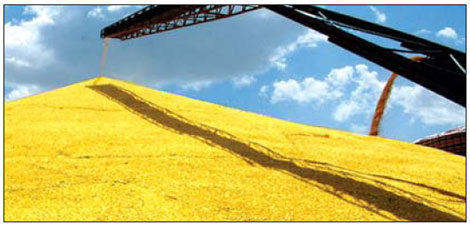Getting more out of China's major granary
|
Jilin province, a key grain producer, is having an especially good harvest this year, thanks mainly to the good weather, some government policies, and hard work. Provided to China Daily |
The large, golden ears of corn glisten in the sunlight, and the rice stalks are weighed down by plump grains, while the tractors rumble back and forth across the fields and farmers sweat to bring in the harvest.
It's autumn in China's Northeast, and Jilin province, a key grain producer, is having an especially good harvest, thanks mainly to the good weather, some government policies, and of course, hard work.
Grain output here is expected to reach 32.5 billion kilograms, nearly 15 percent higher than last year.
"The output figures might drop a bit in the future, but we're still committed to high production," commented Sun Zhengcai, the provincial Party secretary.
"We've been getting more out of Jilin as China's granary."
Jiao Benguo, a farmer in the city of Gongzhuling, said, "The government gives us a subsidy - and honor. We have to work hard."
Jiao owns 32 hectares of land. He said that his fields produce at least 14,000 kilograms of grain per hectare and every hectare of corn brings him more than 14,000 yuan ($2,200) in income. But, because of drought problems in recent years, a harvest such as this year's is a rare occurrence.
To show its gratitude, the city government bought Jiao and a number of other big grain growers a tractor, as a reward.
"We've tried to find ways to inspire the farmers, to give them a passion for their work, by honoring them and giving them machinery as a reward," said Yang Hongbo, Gongzhuling's mayor.
"This year, grain production is expected to exceed 3.5 billion kg, a record."
Nonetheless, that figure is dwarfed by the figures in Nong'an county, a model grain producer. Last year, farmers there harvested 3.3 billion kg, and they expect to take in more than 3.75 billion kg this year.
These advances are also the result of more advanced agricultural technology.
For example, in one Nong'an village, they set up an experimental area with a water-efficient dripping irrigation system. The head of the county, Wang Haiying, said that, in fact, the corn harvest would have been impossible otherwise.
And in the city of Jiutai, agronomists have been busy introducing better technology for every step of the growing process to farmers, all year round.
"We are trying to give more farmers access to the advanced technology and help increase grain production," said Zhang Xiurong, an agronomist.
"In a few years, all the farmers will be agronomists themselves."
Meantime, the government policies and special funding have done their part.
One 27,000-hectare key national irrigation area, at Qianguo, Songyuan city, is having its 32nd consecutive harvest, in spite of the windstorm damage in August.
The government there has put money into infrastructure improvements and water-saving technology to improve facilities and services and has come up with preferential policies. These have made Qianguo the largest bulk and organic rice producer in the province.
(China Daily 10/21/2011 page15)















